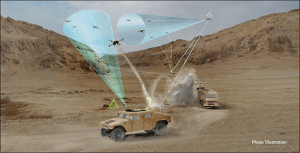The Navy issued a Request For Information (RFI) May 15 looking into sources for specific 40mm grenades to be used in counter-unmanned aerial systems (C-UAS).
The RFI notice, posted to beta.sam.gov, said Naval Surface Warfare Center (NSWC) Crane, Ind., is conducting market research to determine if any sources have 40mm grenades that can be used in C-UASs “that has low collateral damage and limited range.”

It explained this means it is looking for collateral damage measured inside the surface danger zone of a typical M855 cartridge, a maximum range of 3,600 meters, “or has the capability to program the range into the munition.”
The notice said NSWC Crane is particularly interested in technologies like air bursting, short range or reduced range ammunition, shotshells as projectiles or fragments, ammunition using nets as payload, high fragmentation ammunition, and ammunition using explosive powder payloads. However, it underscored they are only interested in 40mm grenades.
Responses are due by June 5.
The Navy has and plans to continue to field directed-energy laser weapons in a largely C-UAS role on a few ships but has not discussed kinetic or explosive C-UAS technologies as widely.
The Navy revealed in February it installed the Navy-built first optical Dazzling Interdictor, Navy (ODIN) C-UAS system on the USS Dewey (DDG-105) and plans for the USS Preble (DDG-88) to be the first ship with the Lockheed Martin [LMT] 60-150 kW High Energy Laser and Integrated Optical-dazzler With Surveillance (HELIOS) system in 2021.
Likewise, after the USS Ponce hosted the Navy’s 30 Kw Laser Weapons System (LaWS) for three years, the service planned to install a 150kW follow-up system on the USS Portland (LPD-27) (Defense Daily, April 25, 2019).